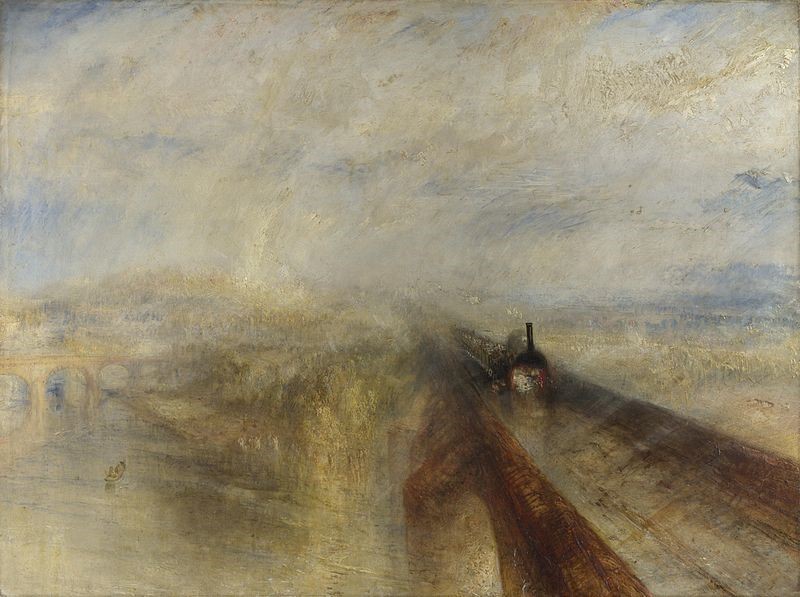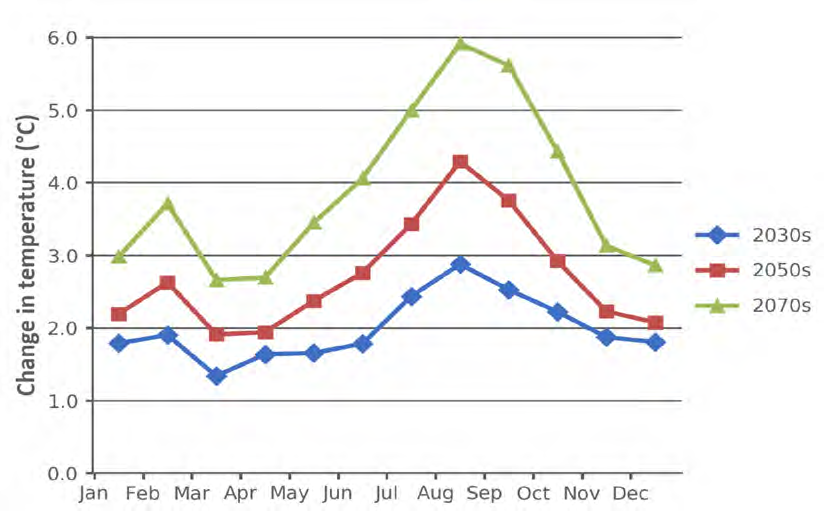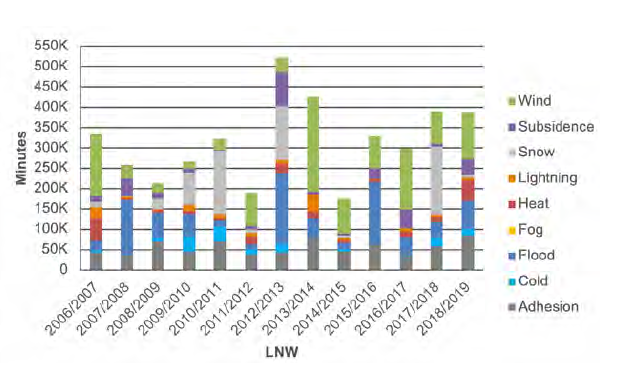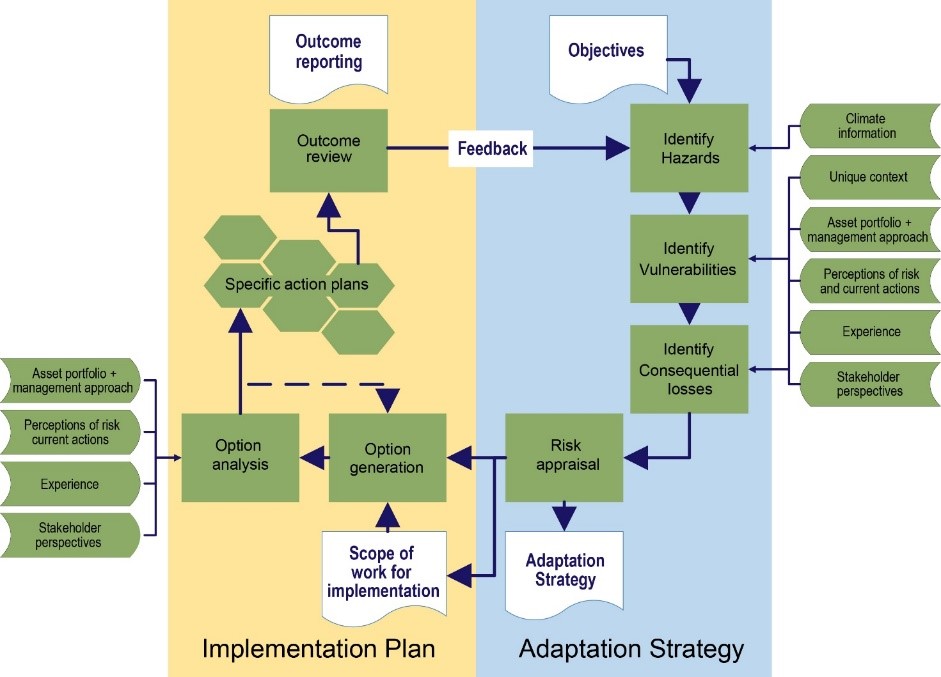by Emma Ferranti, Andrew Quinn, John Dora, Sarah Greenham, Rachel Fisher, Nick Pyatt and Tim Reeder
Extreme weather impacts railway operations causing damage and disruption for passengers. As railway infrastructure (e.g. bridges, embankments) is often longlife (50+ years), it must be resilient to current weather and future climate to enable safe and efficient railway operations. Under the Climate Change Act, Network Rail are mandated to assess their weather and climate resilience, and in 2020 provided their second iteration of plans. This article will examine the efficacy of these new Weather Resilience and Climate Change Adaptation plans against international best practice, and offer recommendations on how Network Rail and the broader transport sector can embed climate adaptation within business as usual. It will present a globally leading framework for climate adaptation that enables any organisation, regardless of its size or climate preparedness to begin the process of adapting to climate change.
Victorian infrastructure and climate change
If you travel from Bristol Temple Meads to London Paddington along the Great Western Railway, your journey will take you through Box Hill Tunnel (originally the world’s longest railway tunnel), over Maidenhead Railway Bridge (Figure 1), on a route that was designed and constructed by the famous Victorian engineer, Isambard Kingdom Brunel between 1830 and 1850. This historic infrastructure predates climate change, and during its construction in preindustrial times, the annual mean UK temperature was approximately 1°C cooler than in the recent decade.
Despite the many declarations of climate emergencies, and current climate pledges and policies to achieve net-zero, global temperatures are likely to be 2°C warmer by 2100. A global warming of more than 1.5°C as compared to pre-industrial levels is associated with the more dangerous impacts of climate change, such as increased frequency of extreme weather and greater sea level rise. UK Climate Projections show that in the future, the UK will have hotter, drier summers and milder, wetter winters. Extreme weather, such as heavy rainfall events or hot summer temperatures are becoming more frequent. Summers like 2018 could happen every other year by 2050. Within this general pattern of climate change there are regional variations; for example, the greatest summer temperature increases and summer rainfall reductions are projected for southern England. Extreme temperatures can cause assets to overheat and become unreliable and heavy rainfall can lead to flooding, landslips, or material washout onto tracks. Slower changes, such as the increased desiccation of clay soil embankments due to hotter drier summers can impact slope stability or track geometry. Sea level rise towards the end of the century may lead to closure or rerouting of some of our coastal railway sections, as the annual cost impact of coastal flooding and storm surges make existing routes no longer operationally viable.
As such, infrastructure operators and owners such as Network Rail must adapt to a changing climate. The railway network is integral to modern society, and weather-related disruption causes wider socio-economic impacts. For example, the closure of the Devon coastal railway line for two months following storm damage at Dawlish in 2014 is estimated to have cost the local economy up to £1.2 billion. Many of us have stories of long journeys home following “no trains north from Euston” or a “bus replacement services between Oxenholme and Edinburgh Waverly”. Most seriously, weather damage to railway infrastructure has the potential to cause derailment and loss of life as in the Stonehaven tragedy 2020, when heavy rainfall was linked to the washout of stones onto the railway line.
Adapting our railway infrastructure is no easy task; the railway network is composed of many different assets of different ages and lifespans, which are vulnerable to different types of weather, and are located in different parts of the country with different geography and geology that experience different types of weather and extreme weather, and different future climate change.
Weather Resilience and Climate Change Adaptation (WRCCA) at Network Rail
Under the Adaptation Reporting Power (ARP) set out in the 2008 Climate Change Act 2008, the Secretary of State can request that infrastructure operators such as Network Rail report on how they are addressing current and future climate impacts. This feeds into the UK Climate Change Risk Assessment, and the National Adaptation Programme. Although the process is not currently mandatory, Network Rail have committed to reporting on their progress and action via the five-yearly ARP process, supported by information and evidence from their Weather Resilience and Climate Change Adaptation (WRCCA) strategy.
Network Rail are implementing their WRCCA strategy through eight Route level action plans, where a ‘Route’ is a Network Rail area of operation such as the ‘Southeast’ or ‘Northwest and Central’. This regionalised approach helps to address the differences in geology, geography and regional climate across Great Britain. The first iteration of the Route WRCCA plans were produced in 2014 (for the 2014-19 period), and these were updated around 2020 for the 2019-2024 planning period. Each WRCCA plan follows the same format for a particular route. The plan initially describes the geography and climate of the Route, to undertake a vulnerability assessment of the Route to current and future weather. For example, it considers how weather, such as maximum temperature, or the consequences of weather, such as increased river flows linked to increased rainfall, will change in the future, along that particular Route (Figure 2). Information on climate change and changing river flows are provided by the Met Office and Environment Agency. The following impact assessment outlines how weather and future climate change can impact different types of assets, such as track, signalling, or buildings. Past performance measured using delay to schedule information (Figure 3) is used to attribute delay minutes and delay costs (the compensation paid out to delayed passengers) to different types of weather along that particular Route. This quantifies the impact of different types of weather or weather hazard for different years and different Routes. Finally, each plan outlines a series of actions to improve the resilience of the Route to weather and climate, and the investment available for the planning period. These might include ‘hard’ adaptation actions, such as asset renewals or repairs, or ‘soft’ adaptation options such as liaising with other stakeholders such as the Environment Agency to reduce flood risk.
Climate Resilience and Adaptation on the Global Scale
Railway infrastructure often has a lifespan of multiple decades. Globally, the climate is changing, and extreme weather and linked hazards such as wildfires and flooding are increasing. It is therefore imperative that railway organisations embed climate adaptation within their business as usual for failure to consider climate change can lead to increased costs or delays in the future. Indeed, the European Union Climate Change Adaptation strategy requires infrastructure operators to undertake resilience assessments as a condition of receiving funding from the European Regional Development Fund and Cohesion Fund. For example, in Slovakia, climate change risks and vulnerabilities were considered in the modernisation of a key passenger and freight railway corridor. This example and others are shared in the EU Climate-Adapt portal which features more than 100 case studies of adaptation from across Europe. Both SNCF (France) and Deutsche Bahn (Germany) have high-level strategies for climate change adaptation.
In order to support sector-wide adaptation to climate change, the Rail Adapt project led by Birmingham Centre for Railway Research and Education (BCRRE) for the International Union of Railways (UIC) collaborated with global transport stakeholders to develop a framework for climate change adaptation that can be used by any organisation, regardless of its current level of climate change awareness (Figure 4). The two-sided framework comprises an adaptation strategy and an implementation plan. The process is circular and iterative which is crucial to incorporate new information and change. This could include new climate information (climate projections evolve in detail and precision), changes to resilience (assets are renewed, assets deteriorate, hazards change), or organisational change (changes to governance or company structure). The Rail Adapt Framework also encourages links with stakeholders, in different parts of the same organisations, and in other sectors. Railway infrastructure rarely operates in isolation, and has interdependencies with the energy sector, who provide power for railway operations, and the ICT sector (Information and Communications Technology) who enable communications. Infrastructure is only as strong as its weakest link, and failure at a critical node, sometimes referred to as a “single point of failure” can lead to cascade failures across multiple infrastructure sectors. For example, the flooding of an electricity supply substation in Lancaster in December 2015 left the city without power for over 30 hours and affected all critical infrastructure including road and rail transport, ICT, water supply, and emergency services.
Next Steps for Network Rail
A comparison of the WRCCA plans with the Rail Adapt framework shows that Network Rail are making good progress at embedding climate adaptation within their business as usual. The WRCCA plans include many core adaptation concepts, such as identifying hazards, vulnerabilities, and losses, and generating action plans. Our research with transport operators indicates that Network Rail are leading the way globally, and that the WRCCA plans should be considered an international example of current best practice in this area. However, in this developing area of infrastructure adaptation to climate change there are opportunities to improve and refine the process. A recent review by BCRRE and Climate Sense highlighted two key areas where the WRCCA plans can be improved, ultimately to increase railway resilience.
Firstly, future iterations of the WRCCA plans should broader in scope and consider interdependencies and interacting risks with other sectors (such as energy supply), and greater extremes of weather and longer-term climate change, including high-level low-probability climate change. This would require greater collaboration with external stakeholders such as local authorities and flood resilience groups at Route-level to support the WRCCA plan development process, but also at a strategic level to align climate resilience agendas across the UK. Network Rail are a member of the Infrastructure Operators Adaptation Forum, an interdisciplinary UK-wide group that facilitates knowledge exchange between senior professionals working in this area, across multiple sectors including national and regional government, to share tacit knowledge provide a collaborative approach to adaptation. Network Rail should also incorporate high-level low-probability climate change, or so called ‘worst-case’ scenarios within their adaptation planning, not least as this is the current government recommendation for sea-level rise.
Secondly, the implementation of the WRCCA plans requires further development to provide greater clarity on option analysis and governance, and to demonstrate line of sight from adaptation needs to asset management. All WRCCA plans provide options to improve resilience, but the rationale behind the prioritisation could be clearer and more consistent. Moreover, following the recent organisational restructure at Network Rail the ownership of the WRCCA plans needs to be restated. More generally, the organisation of investment and planning into five year blocks (known as Control Periods) disconnects with the longer-term view required for effective adaptation. Adaptation pathways, a means by which to plan for long-term change but prioritise short term needs are a potential way forward.
These suggestions for Network Rail improvement highlight the importance of the circular approach to adaptation shown by the Rail Adapt framework that allows for changes to become incorporated within adaptation.
Conclusions
The Great Western Railway, with its historic Brunel engineering serves as a useful reminder of the longevity of our railway infrastructure, and the need for long-term infrastructure adaptation planning. It also predates climate change, and as such was designed for a climate that no longer exists. The Great Western Railway and similar Victorian infrastructure are poignant reminders of how quickly rapid industrialisation produced the carbon emissions that changed our climate.
Today, the railway infrastructure is the backbone of modern society, transporting people and freight around the country. It is an important part of climate mitigation and efforts to meet net-zero by 2050 because rail travel produces far less carbon emissions than travel by private car. The railway network must also be resilient to future weather and climate change. The adaptation challenge facing Network Rail is clear. Weather-related railway disruption must be minimised to reduce socio-economic impacts, but the size, range, and geographic distribution of the railway network (i.e. the very same things that make it backbone of public transport) make this a complex task. That said, Network Rail are leading the way in embedding climate change adaptation as part of business as usual in the rail sector.
Figures

Figure 1: J.M.W. Turner’s 1844 painting entitled Rain, Steam and Speed shows an early steam train crossing the recently completed Maidenhead Bridge. The original painting is now in the collection of the National Gallery, London. National Gallery file

Figure 2: The change in daily maximum temperature for the West Midlands regions for 3 different time slices as determined from the RCP6.0 90th percentile. This graph forms part of the vulnerability assessment for the West Coast Mainline between London Euston and Birmingham and is taken from the Northwest and Central Route weather resilience plans 2019 – 2024 produced by Network Rail. For original data and information on Relative Concentration Pathways (RCP) see UK Climate Projections.
 Figure 3: The delay minutes attributed to different weather types for the Northwest and Central Route that includes the West Coast Mainline between London Euston and Birmingham between 2006 and 2019. Image taken from the Northwest and Central Route weather resilience plans 2019 – 2024 produced by Network Rail.
Figure 3: The delay minutes attributed to different weather types for the Northwest and Central Route that includes the West Coast Mainline between London Euston and Birmingham between 2006 and 2019. Image taken from the Northwest and Central Route weather resilience plans 2019 – 2024 produced by Network Rail.
 Figure 4: The Rail Adapt framework for climate change adaptation. From Quinn et al, 2019
Figure 4: The Rail Adapt framework for climate change adaptation. From Quinn et al, 2019